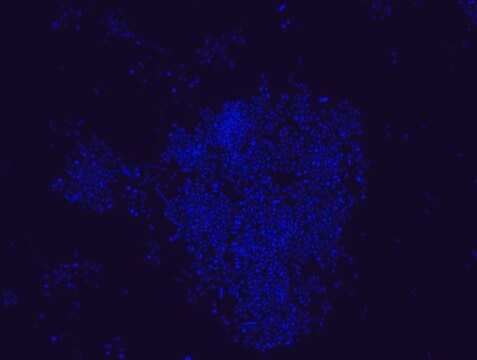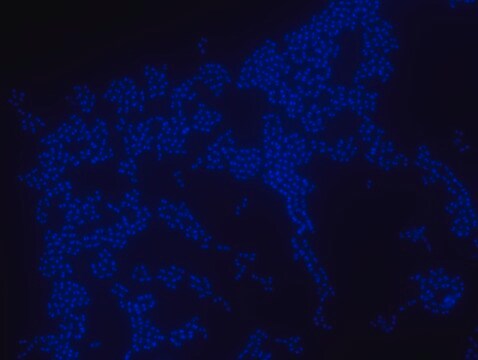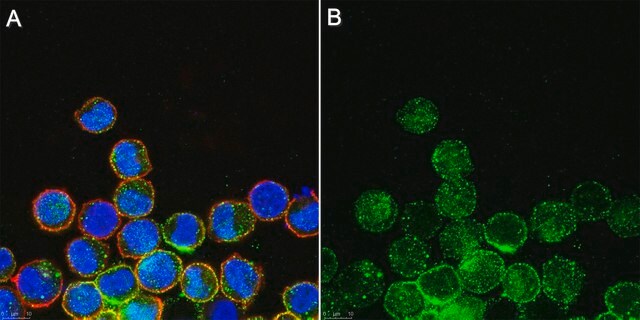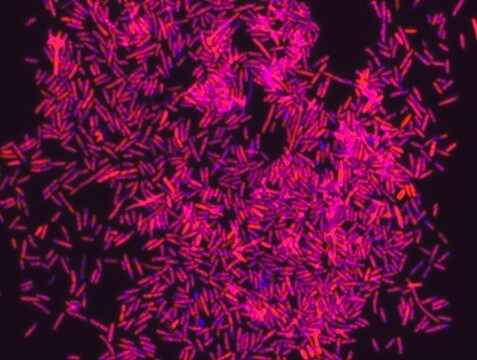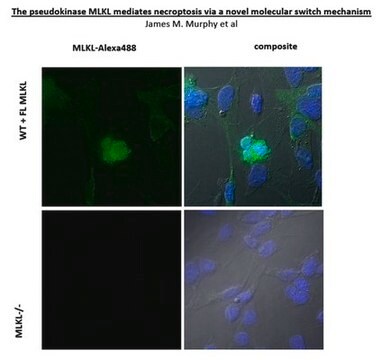MBD0050
Akkermansia muciniphila FISH probe-ATTO488
Probe for fluorescence in situ hybridization (FISH), 20µM in water
Se connecterpour consulter vos tarifs contractuels et ceux de votre entreprise/organisme
About This Item
Code UNSPSC :
41105500
Nomenclature NACRES :
NA.54
Produits recommandés
Niveau de qualité
Technique(s)
FISH: suitable
Fluorescence
λex 504 nm; λem 521 nm
Conditions d'expédition
dry ice
Température de stockage
−20°C
Description générale
Fluorescent In Situ Hybridization technique (FISH) is based on the hybridization of fluorescent labeled oligonucleotide probe to a specific complementary DNA or RNA sequence in whole and intact cells.Microbial FISH allows the visualization, identification, and isolation of bacteria due to recognition of ribosomal RNA also in unculturable samples. FISH technique can serve as a powerful tool in the microbiome research field by allowing the observation of native microbial populations in diverse microbiome environments, such as samples from human origin (blood3 and tissue4), microbial ecology (solid biofilms5 and aquatic systems6) and plants7. It is strongly recommended to include positive and negative controls in FISH assays to ensure specific binding of the probe of interest and appropriate protocol conditions. We offer positive (MBD0032/33) and negative control (MBD0034/35) probes, that accompany the specific probe of interest. Akkermansia muciniphila probe specifically recognizes Akkermansia muciniphila cells. Akkermansia muciniphila is a gram negative, oval shaped, non-motile, non-spore forming strictly anaerobic bacteria.8 A. muciniphila inhabits the gastrointestinal tracts of more than 90% of adults and constitutes 1 to 4% of the fecal microbiota.9 It is one of the top 20 most abundant species detectable in the human gut.10 The mucus layer of the human intestine is a niche which is colonized by specific bacteria such as A. muciniphila. A. muciniphila can degrade mucin, a key mucus component, using the enzymes sialidase and fucosidase, and utilize it as a source of carbon and nitrogen.11 Consequently, the host produces additional mucus while the bacterium produces oligosaccharides and Short Chain Fatty Acids (SCFAs) that can be utilized by the host and trigger the immune system. An additional protective effect of the SCFA is stimulation of mucus-associated microbiota growth, that serves as a barrier against penetration of pathogens to intestinal cells.9,12 It was found that A. muciniphila abundance in the gut was correlated to a healthy intestine and inversely correlated to many disease conditions.11 In comparison to healthy controls, A. muciniphila levels were low in patients with intestinal disorders, such as inflammatory bowel disease (IBD), but also in other conditions, such as autism, atopy, and obesity.11,13-16 Therefore, the level of A. muciniphila was suggested to serve as a biomarker for healthy intestine.17 A. muciniphila is a promising potential probiotic that can be administrated for the treatment of diseases such as, colitis, metabolic syndromes, immune diseases, and cancer.10 FISH technique was successfully used to identify A. muciniphila with the probe in various samples such as pure culture (as described in the figure legends18), fecal samples19-21, gut lumen content22, appendix samples23, cecum content and tissue24,25 and colon tissue26. The probe can also be used for FISH coupled with flow cytometry (FCM-FISH)19,20,21, and FISH combined with Raman microspectroscopy
Caractéristiques et avantages
- Visualize, identify, and isolate Akkermansia muciniphila cells.
- Observe native A. muciniphila cell populations in diverse microbiome environments.
- Specific, sensitive, and robust identification of A. muciniphila in bacterial mixed population.
- Specific, sensitive, and robust identification even when A. muciniphila is in low abundance in the sample.
- FISH can complete PCR based detection methods by avoiding contaminant bacteria detection.
- Provides information on A. muciniphila morphology.
- Identify A. muciniphila in clinical samples such as, gut lumen content, appendix samples (formalin-fixed paraffin-embedded (FFPE) samples), fecal samples and colon tissue.
- The ability to detect A. muciniphila in its natural habitat is an essential tool for studying host-microbiome interaction.
Code de la classe de stockage
12 - Non Combustible Liquids
Classe de danger pour l'eau (WGK)
WGK 1
Point d'éclair (°F)
Not applicable
Point d'éclair (°C)
Not applicable
Faites votre choix parmi les versions les plus récentes :
Certificats d'analyse (COA)
Lot/Batch Number
It looks like we've run into a problem, but you can still download Certificates of Analysis from our Documents section.
Si vous avez besoin d'assistance, veuillez contacter Service Clients
Déjà en possession de ce produit ?
Retrouvez la documentation relative aux produits que vous avez récemment achetés dans la Bibliothèque de documents.
Notre équipe de scientifiques dispose d'une expérience dans tous les secteurs de la recherche, notamment en sciences de la vie, science des matériaux, synthèse chimique, chromatographie, analyse et dans de nombreux autres domaines..
Contacter notre Service technique